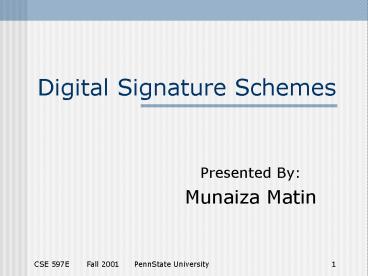Digital Signature Schemes - PowerPoint PPT Presentation
Title:
Digital Signature Schemes
Description:
Digital Signature Schemes Presented By: Munaiza Matin Introduction Cryptography art & science of preventing users from unauthorized or illegal actions towards ... – PowerPoint PPT presentation
Number of Views:329
Avg rating:3.0/5.0
Title: Digital Signature Schemes
1
Digital Signature Schemes
- Presented By
- Munaiza Matin
2
Introduction
- Cryptography art science of preventing users
from unauthorized or illegal actions towards
information, networking resources and services. - Cryptographic transformation conversion of
input data into output data using a
cryptographic key. - Cryptosystem forward and inverse cryptographic
transformation pair
3
A Cryptosystem
Input data
4
Types of Cryptosystems
- Private key cryptosystem a private key is
shared between the two communicating parties
which must be kept secret between themselves. - Public key cryptosystem the sender and receiver
do not share the same key and one key can be
public and the other can be private
5
Types of Cryptosystems
A Private Key Cryptosystem
6
Types of Cryptosystems
Sender
Receiver
Output data
Input data
Input data
Forward Cryptographic Transformation
Inverse Cryptographic Transformation
1st Key
2nd Key
Do not share the same key information and one key
may be public
A Public Key Cryptosystem
7
Digital Signatures
- Encryption, message authentication and digital
signatures are all tools of modern cryptography. - A signature is a technique for non-repudiation
based on the public key cryptography. - The creator of a message can attach a code, the
signature, which guarantees the source and
integrity of the message.
8
Properties of Signatures
- Similar to handwritten signatures, digital
signatures must fulfill the following - Must not be forgeable
- Recipients must be able to verify them
- Signers must not be able to repudiate them later
- In addition, digital signatures cannot be
constant and must be a function of the entire
document it signs
9
Types of Signatures
- Direct digital signature involves only the
communicating parties - Assumed that receiver knows public key of sender.
- Signature may be formed by (1) encrypting entire
message with senders private key or (2)
encrypting hash code of message with senders
private key. - Further encryption of entire message signature
with receivers public key or shared private key
ensures confidentiality.
10
Types of Signatures
- Problems with direct signatures
- Validity of scheme depends on the security of the
senders private key ? sender may later deny
sending a certain message. - Private key may actually be stolen from X at time
T, so timestamp may not help.
11
Types of Signatures
- Arbitrated digital signature involves a trusted
third party or arbiter - Every signed message from sender, X, to receiver,
Y, goes to an arbiter, A, first. - A subjects message signature to number of tests
to check origin content - A dates the message and sends it to Y with
indication that it has been verified to its
satisfaction
12
Basic Mechanism of Signature Schemes
- A key generation algorithm to randomly select a
public key pair. - A signature algorithm that takes message
private key as input and generates a signature
for the message as output - A signature verification algorithm that takes
signature public key as input and generates
information bit according to whether signature is
consistent as output.
13
Digital Signature Standards
- NIST FIPS 186 Digital Signature Standard (DSS)
- El Gamal
- RSA Digital Signature- ISO 9796- ANSI X9.31-
CCITT X.509
14
DSS
- Public-key technique.
- User applies the Secure Hash Algorithm (SHA) to
the message to produce message digest. - Users private key is applied to message digest
using DSA to generate signature.
15
The Digital Signature Algorithm (DSA)
16
DSS
- DSA- M message to be signed- H(M) hash of M
using SHA- M, r, s received versions of M,
r, s
17
El Gamal Signature Scheme
- A variant of the DSA.
- Based on the assumption that computing discrete
logarithms over a finite field with a large prime
is difficult. - Assumes that it is computationally infeasible for
anyone other than signer to find a message M and
an integer pair (r, s) such that aM yrrs(mod p).
18
El Gamal Signature Scheme
19
El Gamal Signature Scheme
Step 1 Randomly choose an integer k such that (k, p-1) 1, 1ltkltp-1, and k has not been used to sign a previous message
Step 2 Calculate r ak (mod p)
Step 3 Find s such that M xr ks (mod (p-1))
Step 4 Collect the pair (r, s) as the digital signature on the message M
- Since, M xr ks (mod (p-1))
- ? aM a(xrks) axraks yrrs(mod p)
- Given M and (r, s), the receiver or 3rd party
can verify the signature by checking whether
aM yrrs(mod p) holds or not.
20
RSA Digital Signature Scheme
- Based on the difficulty of factoring large
numbers. - Given M, RSA digital signature can be produced by
encrypting either M itself or a digest of M using
the private signature key s. - Signature, S ws mod n, where w is message to be
signed or message digest and n pq (p and q are
large primes). - Verification w Sv mod n, where (v, n) is the
public verification key.
21
Conclusions
- Digital signatures are an effective mechanism
used for authenticity and non-repudiation of
messages. - Several signature schemes exist, but DSS is
probably the most popular. - Digital signatures may be expanded to be used as
digital pseudonyms which would prevent
authorities from figuring out a senders
identity, for example by cross-matching
22
Thank you!































